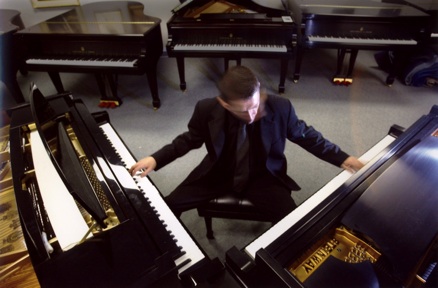
Messiaen’s Vingt Regards sur L’Enfant-Jesus
For the past two weeks San Francisco Performances has presented pianist Marino Formenti in a two-part odyssey into “Aspects of the Divine.” The first concert, on December 5, was dedicated to Olivier Messiaen’s Vingt Regards sur L’Enfant-Jésus (Twenty Meditations on the Baby Jesus), performed at St. John’s Presbyterian Church in Berkeley. Running the gamut from savage to transporting, Formenti’s formidable playing overwhelmed the audience, which responded with an exultant standing ovation punctuated with shouts of approval.
The Messiaen is a mountainous piece, full of unexpected beauty and unexpected darkness. Whimsical runs that climbed to a high point and hovered, deep undertows, mantra-like repetitions and Messiaen’s beloved birdcalls combined to invoke a sense of personal quest and deep religious feeling.
The opening, Regard du Père (Meditation on the Father), was composed of slow arpeggiated chords that rose to a softly insistent note. Serene and distant, this first section focused performer and audience. It was followed by an eerie and exultant passage that paired the highest and lowest octaves.
In the fourth movement, Regard de la Vierge (Meditation on the Virgin), three chords sought release in a fourth. They repeated over and over like rain on parched ground, and Formenti brought absolute focus to each moment. The twenty-movement work took him over two hours to perform.
The sixth, Par Lui tout a été fait (Everything has been made by Him) was mythic, full of the lightning of creation over the thunder of the abyss, its themes recurring cyclically through the piece with high broken-glass chords over rumbling bass.
The tenth, Regard de l’Esprit de Joie (Meditation on the Spirit of Joy) was torrential; Première communion (First Communion) was deep and distracted with trickles of high notes, and La parole toute puissante (The Omnipotent Word) wielded a pounding power.
Huge chords blossomed in the space. St. John’s ceiling is quite high at the stage but drops rapidly with lively wooden surfaces throughout. Because the footprint is only a quarter of a circle, the narrow volume above the stage acts as mixing chamber, and the piano blooms off the walls, sustained but not muddied.
Haydn’s The Seven Last Words and Bernhard Lang’s Monadology V-7
The second concert was at St. Mark’s Lutheran on O’Farrell Street in San Francisco December 12. Like St. John’s, this church, painted in powder blue with a high rounded altar space, has a warm resonance that is neither too lively nor too flat. Formenti divided this concert into two parts, each consisting of a single work: Joseph Haydn’s Seven Last Words of Our Savior on the Cross (1787) and Bernhard Lang’s Monadology V-7, Seven Last Words of Hasan (a U.S. premiere). The Monadologies create “tiny introductory modules, which are used to generate the entire musical fabric”; according to Lang, the basic musical “material comes from Haydn’s Seven Last Words and appears in small cells throughout.” Although posed in mathematical language, Lang’s concept of modules is taken from Liebnitz’ attempts to order the spirit and the soul within creation.
True to Formenti’s mystical sense of the world, the simultaneity of time and the spirituality that it implies, the pianist played Lang’s piece before Haydn’s. Leaping from a chair at one side of the audience, he catapulted onstage, onto the piano bench and keyboard, generating a frenzied density of chords—a deluge of wild sound—after which high notes rippled from the right hand and slow chords radiated from the left hand.
Beginning with the second part, Lang’s piece grew into a conversation between right and left hands, a repeating single note played by one hand, usually the left, rhythmically driving the music forward while the other hand played more lyrical motifs, often collapsing into dissonance or an irregular rhythmic motion. The whole pulsed toward a beautiful meditation in sound and rhythm.
At times the music conjured up naturalistic images: even Messiaen’s birds appeared, singing in some sun-speckled forest. Throughout, the pianist’s near uncanny relationship to silence—the total absence of sound—created large spaces within the music that seemed physical, as if, while walking through that dappled forest, we came upon small, still clearings that opened out into the wide sunlight.
Following the Lang with the Haydn emphasized how structurally similar the two pieces are, even though the two composers’ approaches to music, their commitment to their historical milieus, are completely different. The choice was revelatory. Formenti’s playing was laser focused and vividly pure, brilliant in the depth of its understanding and unrelenting in its impulse toward transcendence.
—Adam Broner and Jaime Robles
Originally published in the Piedmont Post
